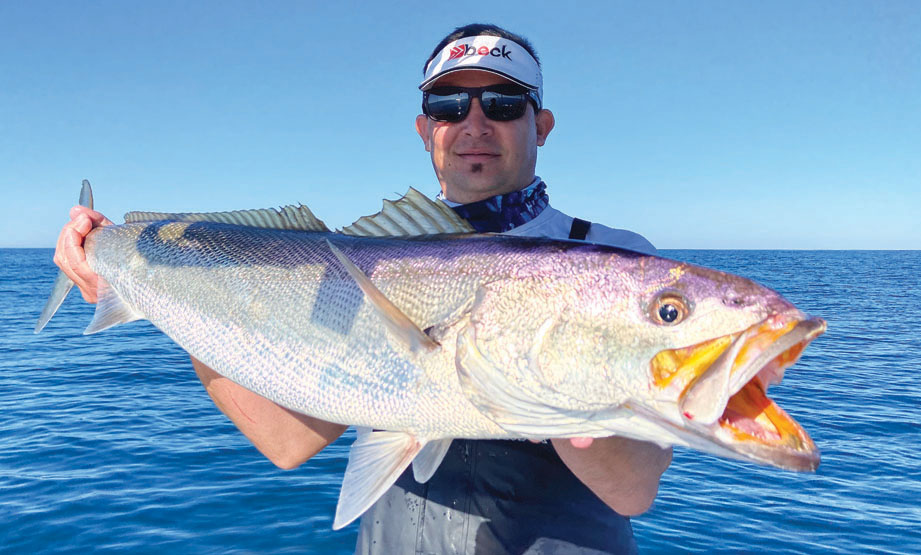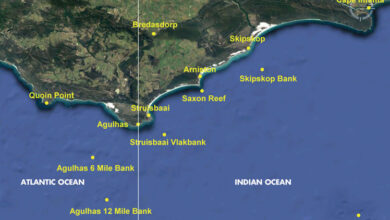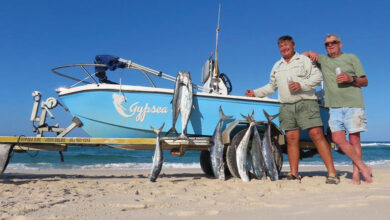’BEK ON THE BOAT
Recreational geelbek fishing off the east coast of Africa
By Francois Beukes
CAPE salmon (atractoscion aequidens) or geelbek, as it is commonly known along the east and west coast of Africa, is one of the most sought-after fish targeted by recreational ski-boat fishermen along our coast. Its features are a dead give-away when boated and it can be identified almost immediately. Although it resembles the common kob, the geelbek’s body is bluish to copper in colour above the lateral line with a white belly below. The name speaks for itself and, as you can imagine, the fish is further identified by the yellow colouring in the mouth and the inner surface of the gill covers, hence the name geelbek.
Although they are sometimes caught from the beach by rock and surf anglers, in the winter months they tend to be more abundant in deeper water from False Bay to the southern border of Moçambique. They are usually associated with the sardine run in winter but have been known to be caught almost all year round in some areas. Although they tend to be more prolific feeders at night, they are also regularly caught during the day.
Geelbek are not unique to South Africa, and I have personally caught them on two previous trips to the Queensland coast of Australia. There they are called teraglen and are often referred to as trag or trag jewfish, but they are identical and also seem to be more abundant in the winter months.
The daily bag limit in South Africa is two fish per angler, with a minimum size of 60cm in length.
HOW AND WHEN
With current Covid-19 restrictions, including a curfew from 9pm to 4am, we recreational fishermen are limited to fishing out of those times and therefore should look at targeting geelbek at first light in the morning or in the dying light in the late afternoon. When they are around they can generally be caught during the day as well.
My tackle of choice when fishing for them is a Poseidon Geelbek ski rod with a 9-inch KP Scarborough reel and 100- to 120 lb braid of your choice. I attach about 5- to 10 metres of 1.0mm leader line (monofilament) to my braid using the old tried and tested GT knot which is then attached to your top swivel of the geelbek trace.
The bite is usually fast and aggressive, and anglers should be prepared at all times when dropping their bait to the bottom. When I feel the bite I start reeling quite fast to set the hook and, if I’m successful with the hook up, I then proceed to reel in the fish in a gradual motion because they have soft mouths and often the loss of a geelbek is a direct result of the angler reeling in too aggressively. Multiple hook ups on a two hook trace are usually quite common when you locate a shoal.
Once a shoal is located on your fish finder it’s a good idea to put an anchor down and fish the spot.
Always remember to stick to the legal limit of two per person because when a shoal is located and they are feeding it is very easy to catch your quota quickly. They are extremely good fun to catch as they often put up a fight from the time they are hooked up to the time they reach the surface.
RECOMMENDED TRACE
The geelbek trace I prefer to use is a standard two hook paternoster trace. (as illustrated above). It is advisable to use anything from .60mm to 1.0mm diameter line for both your hook snoot lines as well as the line between your swivels and sinker.
On one of the two hooks I like using a green glow bead inserted into a green live glow skirt which is pulled down to the eye of the hook. The other hook I leave bare. The thinking here is to see which of the two variations has a better hook up rate and then possibly change your trace to either two hooks with glow beads and skirts or just two bare hooks.
The hooks I use vary in size between a size 6.0 and 9.0. It depends on personal preference, but either a J hook or a circle hook will get the job done.

BAIT
We generally use a whole sardine as bait, and insert the hook through the lower jaw between the eyes and out through the top of head; this is extremely successful when targeting geelbek. You can also thread the hook through the eyes of the sardine and bury it into the body about a third of the way down.
I also sometimes use livebait such as mackerel or maasbanker which increase the hook up rate when the sardines or other soft baits like strips of fish fillets and chokka are not working. The livebait is usually rigged up by inserting the hook into its open mouth and out through the top part of the head between the eyes.
Geelbek can sometimes be stubborn feeders, and when all else fails a flapper bait or a pilchard turned inside out and tied onto the hook with cotton could attract them and entice a bite.
COOKING
Geelbek are excellent eating fish once cleaned and prepared. I like mine fried in flour and egg batter, but it’s also good eating on the braai or in the oven wrapped in tinfoil with garlic, fish spices and a choice of sliced onion and tomato and served with freshly cut lemon.
Bon apetit!






